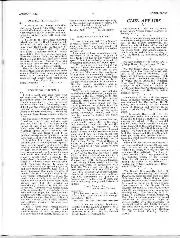
Unsprung old 'uns ?
Sir, I feel I must join issue with your correspondent, Mr FW Bottomley (November issue) on behalf of some "modern machinery," when he says of the Riley Nine that "the steering was a delight…
The Action of the ” Zenith.” In order to understand the action of the Zenith carburettor, which is applied in more or less modified form to other types, if is well to realise at once exactly how it happens that simple carburettors frequently fail to produce a correct mixture under all conditions. In the simple carburrettor then—that is one which comprises a fuel chamber, a single air entrance and a single jet—suction created by the action of the engine causes fuel and air from the carburettor to flow into the combustion chamber ; but, owing to fuel being more responsive to suction than air, its flow becomes more rapid as the engine speed increases, thus producing an excessively rich mixture. In the Zenith carburettor, however, this difficulty has been overcome by so arranging the fuel jets that they accurately proportion the fuel and air flows in accordance with the suction, this being accomplished by natural, and not mechanical, methods. Thus, in the Zenith carburettor, there is provided a compensating jet, the function of which is to allow the mixture to weaken under increasing suction, together with a further combination of two jets in the form of one compound jet, by means of which the carburettor delivers a correctly proportioned mixture at all engine speeds. The accompanying illustration shows the four parts upon which the correct proportions of the mixture depend, the sizes of these parts depending on the specific requirements of individual engines. These are : a, the choke tube (x), which measures the amount of air taken into the engine ; b, the main jet (8), which acts exactly in the same way as the jet on a simple carburettor ; c, the compensating jet (6), from which the flow is constant, regardless of the amount of suction or speed of the engine ; and d, the slow-running jet (2), which only operates when the throttle is practically closed and goes out of action automatically as soon as the other jets come into action. As soon as the petrol
from the tank is allowed _to flow into the float chamber, the needle valve mechanism regulates the petrol level to a height corresponding to the tops of the slow-running jet (2) and the compound jet (4), the compensator jet (6) remaining submerged.
Setting the Carburettor for Starting and Slow Running. When cranking the engine for starting, the throttle is opened very slightly, allowing strong suction on the orifice (10) and the tube (9) communicating with the slow-running jet (2). Thus a relatively strong mixture is drawn up for easy starting and for allowing the engine to” idle.” It is important to observe that slow running does not only apply to the facility with which an engine will” tick over” at low speeds, but also has a considerable effect on the speed with which it will accelerate. If the slow-running mixture is allowed to become too rich, hesitation and choking will occur when the throttle is opened up, whilst, on the other hand, an unduly weak mixture will cause loss of power and misfiring. The adjustment for the slow-running jet is effected by regulating the knurled knob (9), which raises or lowers an internal cone sleeve over the jet proper, thus controlling the amount of petrol passing into the orifice (10). When regulating this adjustment, the knob is first turned